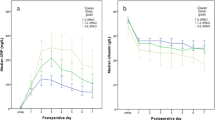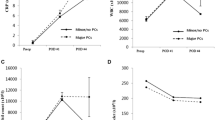Abstract
Purpose
Although widely used, there is a lack of evidence concerning the diagnostic accuracy of C-reactive protein (CRP) and white blood cell counts (WBCs) in the postoperative period. The aim of this study was to evaluate the diagnostic accuracy of CRP and WBCs in predicting postoperative inflammatory complications after open resection of colorectal cancer.
Methods
In this retrospective study, clinical data and the CRP and WBCs, routinely measured until postoperative day 5 (POD 5), were available for 1,187 patients who underwent colorectal cancer surgery between 1997 and 2009. Using the receiver-operating characteristic (ROC) methodology, the diagnostic accuracy was evaluated according to the area under the curve (AUC).
Results
Three hundred forty-seven patients (29.2%; 95% CI, 26.7–31.9%) developed various inflammatory complications. Anastomotic leakage occurred in 8.0% (95% CI, 6.1–9.1%) of patients. The CRP level on POD 4 (AUC 0.76; 95% CI, 0.71–0.81) had the highest diagnostic accuracy for the early detection of inflammatory complications. With a cutoff of 123 mg/l, the sensitivity was 0.66 (95% CI, 0.56–0.74), and the specificity was 0.77 (95% CI, 0.71–0.82). The diagnostic accuracy of the WBC was significantly lower compared to CRP.
Conclusion
Measurement of CRP on POD 4 is recommended to screen for inflammatory complications. CRP values above 123 mg/l on POD 4 should raise suspicion of inflammatory complications, although the discriminatory performance was insufficient to provide a single threshold that could be used to correctly predict inflammatory complications in clinical practice. WBC measurement contributes little to the early detection of inflammatory complications.
Registered at www.clinicaltrials.gov (NCT01221324)



Similar content being viewed by others
References
Velasco E, Thuler LC, Martins CA, Dias LM, Conalves VM (1996) Risk factors for infectious complications after abdominal surgery for malignant disease. Am J Infect Contr 24(1):1–6
Nakamura T, Mitomi H, Ihara A, Onozato W, Sato T, Ozawa H, Hatade K, Watanabe M (2008) Risk factors for wound infection after surgery for colorectal cancer. World J Surg 32(6):1138–1141
Rovera F, Dionigi G, Boni L, Piscopo C, Masciocchi P, Alberio MG, Carcano G, Diurni M, Dionigi R (2007) Infectious complications in colorectal surgery. Surg Oncol 16(Suppl 1):S121–S124
Hyman N, Manchester TL, Osler T, Burns B, Cataldo PA (2007) Anastomotic leaks after intestinal anastomosis: it's later than you think. Ann Surg 245(2):254–258
Welsch T, Muller SA, Ulrich A, Kischlat A, Hinz U, Kienle P, Buchler MW, Schmidt J, Schmied BM (2007) C-reactive protein as early predictor for infectious postoperative complications in rectal surgery. Int J Colorectal Dis 22(12):1499–1507
Chromik AM, Endter F, Uhl W, Thiede A, Reith HB, Mittelkotter U (2006) Pre-emptive antibiotic treatment vs ‘standard’ treatment in patients with elevated serum procalcitonin levels after elective colorectal surgery: a prospective randomized pilot study. Langenbecks Arch Surg 391(3):187–194
Rivers E, Nguyen B, Havstad S, Ressler J, Muzzin A, Knoblich B, Peterson E, Tomlanovich M (2001) Early goal-directed therapy in the treatment of severe sepsis and septic shock. N Engl J Med 345(19):1368–1377
Sponholz C, Sakr Y, Reinhart K, Brunkhorst F (2006) Diagnostic value and prognostic implications of serum procalcitonin after cardiac surgery: a systematic review of the literature. Crit Care 10(5):R145
Simon L, Gauvin F, Amre DK, Saint-Louis P, Lacroix J (2004) Serum procalcitonin and C-reactive protein levels as markers of bacterial infection: a systematic review and meta-analysis. Clin Infect Dis 39(2):206–217
Mayer J, Rau B, Gansauge F, Beger HG (2000) Inflammatory mediators in human acute pancreatitis: clinical and pathophysiological implications. Gut 47(4):546–552
Mofidi R, Duff MD, Wigmore SJ, Madhavan KK, Garden OJ, Parks RW (2006) Association between early systemic inflammatory response, severity of multiorgan dysfunction and death in acute pancreatitis. Br J Surg 93(6):738–744
Pepys MB, Hirschfield GM (2003) C-reactive protein: a critical update. J Clin Invest 111(12):1805–1812
Reith HB, Mittelkotter U, Debus ES, Kussner C, Thiede A (1998) Procalcitonin in early detection of postoperative complications. Dig Surg 15(3):260–265
Matthiessen P, Henriksson M, Hallbook O, Grunditz E, Noren B, Arbman G (2008) Increase of serum C-reactive protein is an early indicator of subsequent symptomatic anastomotic leakage after anterior resection. Colorectal Dis 10(1):75–80
Korner H, Nielsen HJ, Soreide JA, Nedrebo BS, Soreide K, Knapp JC (2009) Diagnostic accuracy of C-reactive protein for intraabdominal infections after colorectal resections. J Gastrointest Surg 13(9):1599–1606
Mackay GJ, Molloy RG, O'Dwyer PJ (2011) C-reactive protein as a predictor of postoperative infective complications following elective colorectal resection. Colorectal Dis 13(5):583–587
Woeste G, Muller C, Bechstein WO, Wullstein C (2010) Increased serum levels of C-reactive protein precede anastomotic leakage in colorectal surgery. World J Surg 34(1):140–146
Agresti A, Coull BA (1998) Approximate is better than “exact” for interval estimation of binomial proportions. Am Stat 52:119–126
Hanley JA, McNeil BJ (1982) The meaning and use of the area under a receiver operating characteristic (ROC) curve. Radiology 143(1):29–36
DeLong ER, DeLong DM, Clarke-Pearson DL (1988) Comparing the areas under two or more correlated receiver operating characteristic curves: a nonparametric approach. Biometrics 44(3):837–845
Boos DD (2003) Introduction to the bootstrap world. Stat Sci 18(2):168–174
DiCiccio TJ, Efron B (1996) Bootstrap confidence intervals. Stat Sci 11(3):189–212
Pepe MS, Thompson ML (2000) Combining diagnostic test results to increase accuracy. Biostatistics 1(2):123–140
Karanicolas PJ, Dubois L, Colquhoun PH, Swallow CJ, Walter SD, Guyatt GH (2009) The more the better?: the impact of surgeon and hospital volume on in-hospital mortality following colorectal resection. Ann Surg 249(6):954–959
Richards CH, Leitch FE, Horgan PG, McMillan DC (2010) A systematic review of POSSUM and its related models as predictors of post-operative mortality and morbidity in patients undergoing surgery for colorectal cancer. J Gastrointest Surg 14(10):1511–1520
Greiner M, Pfeiffer D, Smith RD (2000) Principles and practical application of the receiver-operating characteristic analysis for diagnostic tests. Prev Vet Med 45(1–2):23–41
Pewsner D, Battaglia M, Minder C, Marx A, Bucher HC, Egger M (2004) Ruling a diagnosis in or out with “SpPIn” and “SnNOut”: a note of caution. BMJ 329(7459):209–213
Wilensky GR (2006) Developing a center for comparative effectiveness information. Health Aff (Millwood) 25(6):w572–w585
Sox HC, Greenfield S (2009) Comparative effectiveness research: a report from the Institute of Medicine. Ann Intern Med 151(3):203–205
Author information
Authors and Affiliations
Corresponding author
Rights and permissions
About this article
Cite this article
Warschkow, R., Tarantino, I., Torzewski, M. et al. Diagnostic accuracy of C-reactive protein and white blood cell counts in the early detection of inflammatory complications after open resection of colorectal cancer: a retrospective study of 1,187 patients. Int J Colorectal Dis 26, 1405–1413 (2011). https://doi.org/10.1007/s00384-011-1262-0
Accepted:
Published:
Issue Date:
DOI: https://doi.org/10.1007/s00384-011-1262-0




